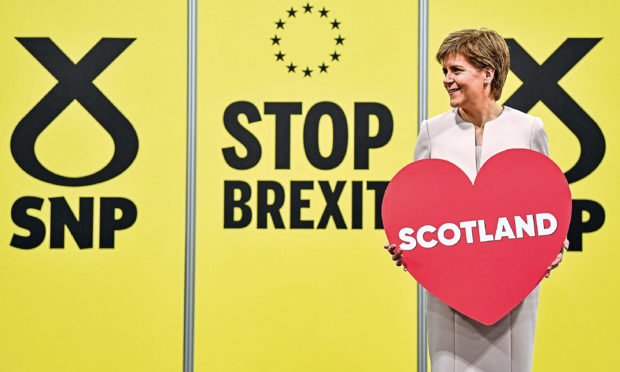Apparently indyref2 will happen next year.
How, nobody can reliably say, but the SNP conference said it out loud so it must be true.
Given the mess Brexit has got us into (it might finally be solved as you read this, but then again…) it is worth making sure we avoid confusion.
The Nats want to ask the same question as last time.
Should Scotland be an independent country?
Nice and simple, no ifs and buts, no loaded language.
And there lies the legal truth.
The people will be asked it, and whatever answer they give will be pertinent only to it.
Which is a big problem for the SNP.
The governing party have a market-tested offer of scrapping trident, keeping sterling, staying in NATO and staying in the EU.
Not only that, but our land will be fairer, richer and nicer to puppies.
All these positions are designed to either outflank unionist offers or make Indy look stable.
The problem is that none of these are included in the question.
If the old question is rerun, then the only thing at issue is “independence” – whatever that means.
The Brexit referendum question is a useful lesson.
Should the UK remain a member of the EU or leave the EU?
That’s was the question asked and answered – and look at the confusion that followed.
What went wrong for Brexit was it asked a general question which was then interpreted by politicians.
The politicians had clear, if conflicting ideas, and set about creating a Brexit that was agreeable to Conservatives and the DUP.
But the people were not asked – “Do you want the government of the day to negotiate a deal which suits its short term electoral interests?”
Had they been, the answer may have been no.
Yet that is what we have.
For indyref2 the danger is clear – the nation votes on a general principle which is then subject to the political needs of the governing party.
In 2014 the SNP tried to have this both ways – ask a broad question but define it by party political requirements.
The electoral commission allowed this – it was naive about how confusing an apparently simple question can become.
It will not be so easy in future.
In truth the SNP mean to ask “do you approve the Scottish Governments white paper for independence”
That is, Sturgeon is saying accept independence as defined by her.
In itself, that would fine, but the SNP’s version contains elements out of its, and the UK’s, control.
Neither Edinburgh nor London can determine NATO membership – that’s between NATO and a potential member.
Same too for the EU – becoming independent will put Scotland out of Europe.
The question of getting back in is not in the gift of an independence negotiation.
The SNP offer also contains elements which would restrict Scotland’s negotiators, much in way Tory red lines messed up Brexit.
Insisting on a removing Trident is actively unhelpful when so much is at play, and Scotland’s leverage is limited.
If the motive for independence is to “bring the powers home” and put Scots in charge of their own destiny, then it is perverse to say that one Indy vote decides all sorts of matters.
From a legal point of view, the matter of NATO membership would be for parliament after independence is done.
Much as EU membership would probably require a separate referendum, after Indy.
It seems the SNP are set on asking the wrong question as it does not accurately reflect their intention.
That said, the existing question is nice and simple – if kept out of the hands of politicians.
Should Scotland vote yes in indyref2 to the same question as last time, then the matter should be handed over to lawyers, not politicians.
The nation will have said we want a new kind of sovereignty and status, but as this cannot be clear until after it is negotiated, we give permission for the negotiators to do their best.
That is an honest, reasonable and legal consequence of the existing question.
It would only be honest, reasonable and legal to expect the SNPs version if the question was to “do you want the SNPs version.”
None of this should be problematic to the SNP.
Ask the old question, get a Yes result, hand it over to a negotiating team, and start preparing for the new world.
Yet it does trouble the Nats because they want to control the process.
In wanting to have it both ways – a general question but a prescriptive answer – they run the risk of a Brexit-style bourach.
It could mean we will be in and out of the Court of Session, down and up between London and Edinburgh, treading on the toes of important neighbours in Ireland and the continent in the process.
Instead, the Scottish government’s next white paper should focus on the process alone, on the issues to be resolved around assets and obligations and the absolute imperative of sustainable good relations on these isles.
All other promises are party political, and for the independent state to determine.
Ask an honest question, seek and honest answer and then trust the people.
Which is rather the point, isn’t it?










